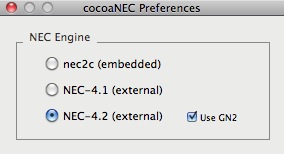
Using NEC-4 with cocoaNEC
Kok Chen, W7AY [w7ay (at) arrl (dot) net]
Last updated: May 25, 2012
Primary differences between NEC Engines
cocoaNEC 2.0 comes with an embedded NEC-2
engine. NEC-2 is sufficiently accurate for many antenna
modeling purposes, but does not work for buried wires or
models with wires that are close to ground. The embedded
NEC-2 engine is significantly faster than NEC-4.
NEC-3, and the current NEC-4 program which superseeds
NEC-3, allows buried wires and wires close to ground to be
modeled correctly. NEC-4 further allows electrically small
antennas to be modeled with better accuracy.
NEC 4.2 improves upon NEC 4.1 by providing a better
Sommerfeld ground model. NEC-4.2 is also no longer limited
by the size of memory that is allocated at compile time;
memory is expanded as the antenna model grows in size. In
addition to voltage sources, NEC-4.2 now allows current
sources to be specified (this function has already been
provided by cocoaNEC).
NEC-4
The NEC-4 program is licensed by the Lawrence Livermore
National Laboratory (LLNL) and is under United
States export control. Please refer to the LLNL
web page here for information on how to obtain
NEC-4.
Because of the export control, there is no other way for an
individual to obtain NEC-4 other than going through the
process described in the aforementioned web page. To use
NEC-4 with cocoaNEC, you will have to be personally
licensed by the Lawrence Livermore Lab.
The current NEC-4 version is NEC-4.2.
As of May 2012, the documentation still mentions that
NEC-4.2 should be considered as beta software. If you have
a license for NEC-4 on record at the LLNL, you can contact
Jerry Burke for a copy of NEC-4.2. Both NEC-4.1 and NEC-4.2
are present in the current distribution CD-ROM.
NEC-4 is not available as a prebuilt program for Unix based
operating systems. You have to build your own Unix executable binary from the sources
that are in the CD-ROMs. Please refer to the NEC-4.1 and NEC-4.2 pages for instructions on
how to build the executables which run on Mac OS X.
cocoaNEC assumes that the Unix executable for NEC-4.1 is
saved in the /Applications folder as a file named nec4d and
the executable for NEC-4.2 is saved in the /Applications
folder as a file named nec4d42.
Selecting a NEC Engine
To select NEC-4.1 or NEC-4.2 as the compute engine, open
the Preferences panel (Preferences menu item in the
cocoaNEC menu in the main menu bar) and choose "NEC-4.1
(external)" or "NEC-4.2 (external)" as shown below:

Once selected, the NEC Engine
setting will be saved to your cocoaNEC plist (preference
list) file when you exit cocoaNEC. The next time you launch
cocoaNEC, you will be using the same engine that you had
previously selected.
As with the case of the built-in NEC-2 engine (nec2c),
cocoaNEC first generates a card deck file from either an NC
program or a spreadsheet.
When NEC-4.1 (or NEC-4.2) is selected as the compute
engine, cocoaNEC runs nec4d (or nec4d42) as a MacOS X task.
cocoaNEC sends NEC-4 the names of the card deck file and
the name of the file that NEC-4 writes its output to.
cocoaNEC waits for the task to finish execution, it then
proceeds to parse the NEC-4 output into the familiar
graphical views in the cocoaNEC output window.
The Use GN2 checkbox lets you choose the old
Sommerfeld ground model instead of the newer GN3 in NEC-4.2
when you ask for the Sommerfeld ground approximation.
One difference that you will notice when using NEC-4 is
that the MacOS X Activity Monitor will show an extra
process which runs for the duration that NEC engine is
running (e.g., while the circular progress indicator that
is next to the NC window's Run button is active).
You can dynamically select between using the nec2c engine
and a NEC-4 engine. The same model that is run under nec2c
and under NEC-4 will appear as separate contexts in the
output window. This allows you to compare the outputs from
NEC-2 and NEC-4.
The output of the model that is produced using the NEC-4
engine will appear as a context whose name has "(NEC-4.1)"
or "(NEC-4.1)" appended to it, as shown below:

The summary view of the output
window will also indicate the engine you have selected for
the run:

Building the NEC-4 Unix Executable
Please continue to the following sections
for instructions on how to build the Mac OS X Unix
executables for NEC-4.1 and NEC-4.2 . If you don't already have
the gfortran compiler installed on your computer, please
follow the instructions in the following gfortran page. gfortran does not
come with Mac OS X.